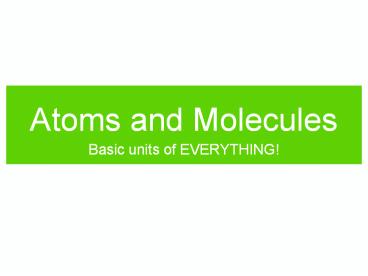Atoms and Molecules PowerPoint PPT Presentation
Title: Atoms and Molecules
1
Atoms and Molecules
- Basic units of EVERYTHING!
2
Which of these is true?
- Atom and molecule mean the same thing.
- Atoms are made of molecules.
- Molecules are made of atoms.
3
What is the smallest structure in this list that
can be seen with an ordinary desk microscope?
- Cells.
- Cell nucleus.
- Atoms.
- Chain molecules, such as proteins.
4
Atoms
5
In our model of scale, remember that the BB
represented an atom.
6
Hydrogen
Helium
As a class, identify the atoms represented here
and label the sub-atomic particles.
7
Carbon
Oxygen
Phosphorous
Calcium
What elements are represented here? Use the
Periodic Table on the wall to identify these
atoms. What does the term valence shell mean?
Label the valence shell on each of these.
8
Ions
Loss or gain of an electron makes an atom into an
ion.
Losing an electron makes a positive or negative
ion?
-
Gaining an electron makes a positive or negative
ion?
-
9
Isotopes
Atoms that gain or lose a neutron become
isotopes. Radioactive isotopes are used in
medicine for imaging (such as PET scanners).
10
Why is this important?
- Each element has distinct properties color,
melting point, reactivity, etc. - The basic atomic structure of each element
determines that elements properties. Change the
structure, and you have an entirely different
element.
11
Which of these is found in the nucleus of an atom?
- Protons
- Electrons
- DNA
- Depends on the atom
12
An ion is an atom that has lost or gained
- An electron
- A proton
- A neutron
- Any sub-atomic particle
13
T or F An atomic nucleus and a cell nucleus are
about the same size.
- True
- False
- Depends on which cell and which atom.
14
Atoms bond together
- Molecules are made up of atoms bonded together.
- The structure of an individual atom determines
- Whether the atom can form bonds.
- How many other atoms it can bond to.
15
In our model of scale, remember that the marble
represented a small molecule, such as glucose.
16
How many atoms can each of these atoms bond
with? How do we know?
17
1
4
3
2
5
2
Fill in the blank column with number of covalent
bonds formed by each atom.
18
Ionic Bonding
19
Ionic substances tend to form crystaline lattices
rather than distinct molecules.
20
Covalent Bonding
Co together valent valence shells
The hydrogen atom. How many bonds can it form?
21
Covalent bonding
A hydrogen molecule. How many hydrogen atoms are
involved? Can there be more? Why or why not?
22
W O R K T O G E T H E R
- Describe in your own words the difference between
ionic and covalent bonding.
23
Covalent Bonding
24
Polar bonding between atoms produces a polar
molecule, which has areas with slightly positive
or slightly negative charges.
25
W O R K T O G E T H E R
- Describe in your own words the difference between
nonpolar and polar covalent bonding
26
When atoms bond together, they make
- Cells
- Molecules
- More atoms
- Ions
- Isotopes
27
Which of these is true?
- Molecules and cells are about the same size.
- Molecules are much smaller than cells.
- Cells are much smaller than molecules.
- Cell and molecule mean the same thing.
28
Which kind of bond between atoms creates a
distinct molecule?
- Ionic bonding
- Covalent bonding
- Both ionic and covalent bonding.
29
Which is true about polar covalent bonding?
- An electron is shared equally between two atoms.
- An electron is shared unequally between two
atoms. - An electron leaves one atoms and becomes part of
another.
30
True or false? The atomic shell is a cell
membrane.
- True
- False
31
Why is polarity so important?
Salt dissolves in water.
Oil does not.
Why?
What will oil dissolve in? Why?
32
W O R K T O G E T H E R
- Is a water molecule in the gas phase larger than,
smaller than, or the same size as a water
molecule in the solid phase? - Describe what happens to water molecules as
liquid water evaporates.
33
Molecules bond together
Weak attractive forces between molecules are
called hydrogen bonds.
34
Here, sugar (a polar substance) is in solution
with water (also polar). Mark where the hydrogen
bonds will form.
35
Hydrogen bonding occurs
- Between atoms.
- Between molecules.
- Between cells
- Between any particles.
36
Hydrogen bonding is
- Strong and difficult to break, like polar
covalent bonding. - A strong attraction between charged ions, like
ionic bonding. - A weak attraction between polar molecules.
37
Properties of Water
- Water is
- Cohesive
- Adhesive
- A universal solvent
- Water also has
- A high specific heat
- A high heat of vaporization
38
pH is a ratio between H and OH- ions in solution.
39
W O R K T O G E T H E R
- One unusual property of water is that it is less
dense in the solid stage than in the liquid
stage, which causes ice to float. Why does water
become less dense as it freezes? Use what you
learned about hydrogen bonding between molecules.
40
Recap
- What is the difference between atoms and
molecules? - What is the difference between ionic bonding and
polar covalent bonding? - How is polarity related to pH?

